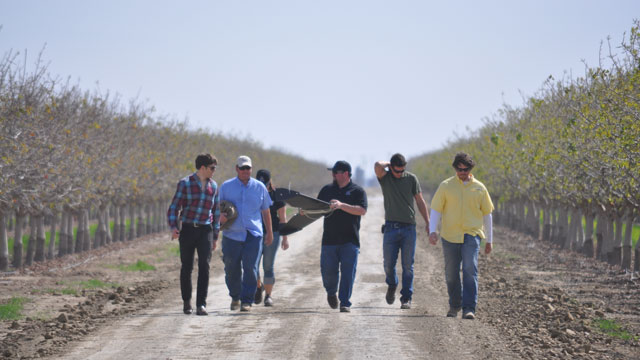Farmers represent a growing share of the market for UAS, and in California, some farmers are looking at the technology as a way to save water during the drought.
32-year-old Zach Sheely was already on the cutting edge of water conservation, using his iPhone to check how much water his tomatoes were getting – Sheely and his dad, Ted, were among the first to convert to remote-controlled drip irrigation on their sprawling Kings County farm. Now they’re taking one more step into the future.
‘We don’t have enough water, and having a coyote chew a line in two, now that line of trees is getting half the water.’They recently gathered some of their neighbors to watch a demo of a drone that can collect video and thermal images of farmland.
“You’ve got a tablet which is going to help figure out the mission, and is connected to a ground control station,” Zach Sheely explains.
Listening to farmers programming a UAS is sort of like eavesdropping on NASA’s Mission Control. But the mission here has to do with coyotes gnawing the two rows of drip irrigation lines that feed pistachio trees. The Sheelys grow more than a thousand acres of pistachios in this remote corner of Kings County.
“We don’t have enough water, and having a coyote chew a line in two, now that line of trees is getting half the water,” Ted says. “We’ve got to be precise.”
While coyotes are the main culprits, two-legged interlopers can be just as much of a headache, Zach adds.
“Humans are a problem,” he says. “They’ll come out and hunt doves or something in our orchard, and the shotgun BBs will put little holes in all the lines. We do have no trespassing signs, but those are just signs, I think, to most people.”
The Sheelys are hoping a thermal camera mounted in the drone will pick up leaks in the orchard, so they can fix them faster.
They’ve invited several UAS companies to the farm to demo their crafts, including a company called HoneyComb. That company is the brainchild of a group of 20- and 30-somethings like John Faus, who grew up farming in Oregon.
“We designed this for farming,” Faus says. “That’s why it’s called HoneyComb. This is your worker bee out over your fields scanning your crops.” ‘We want it to be the tractor of the sky.’
But demo day turns out to be really windy. And the little plane careens wildly above the orchard before a rocky landing on a dirt road. “Sorry you got a little ding in your wing there!” Ted Sheely exclaims.
“Nothing a little gorilla glue can’t fix,” Faus says. “Our motto is we want it to be the tractor of the sky. We want it to be reliable and rugged.” He says his company can’t keep up with orders for farm drones fast enough.
Zach Sheely says he’s sold on the UAS, which will set him back about $15,000. He says that’s far less than what the lost water from leaks might cost him.
A UAS can cover a thousand acres in an hour-long flight. Zach says it would take a farmworker more than a week to drive up and down the same orchards in an all-terrain vehicle, looking for chewed irrigation lines.
‘For agricultural purposes, they’re going to be a real powerful tool.’
“So if I can eliminate that job,” he says, “or use that person more wisely than just drive up and back mindlessly looking for leaks, it’s going to benefit my business, and he’s probably going to like his job a little bit better, too.”
Irrigation experts say California farmers looking to save water will be early adopters of UAS technology, and not just to check for leaks. Drones can help determine when plants are water-stressed or when they’re getting too much water, by using thermal cameras.
“For agricultural purposes, they’re going to be a real powerful tool” says David Zoldoske, who heads the Center for Irrigation Technology at Fresno State , and co-authored a recent state report on water-saving technologies.
UAS will help farmers “to get more information, in real time, to make better decisions,” about everything on the farm, adds Zoldoske. “We joke about being able to take pictures of individual bugs sitting on the plants. With the right algorithm you could count all the bugs on the plants if things work out.”
Right now that’s still a big if. It’s still unclear how much leeway farmers will have to fly drones. At this point, the FAA does not allow their commercial use. Farm groups have been weighing in heavily to change that. Later this year, the agency may propose rules to cover the small UAS that farmers are starting to buy.
Photo: John Faus of HoneyComb demonstrates an agricultural drone in a pistachio orchard – Zach Sheely
Source: KQED

